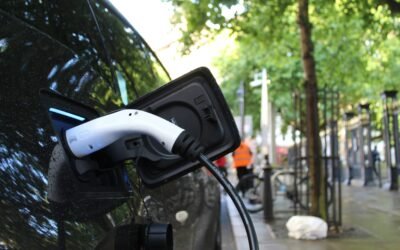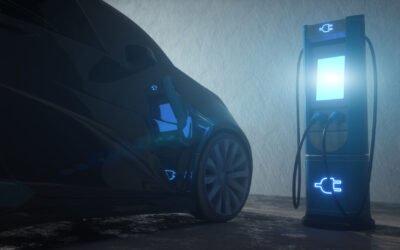- The benefits of incorporating Plug&Charge include streamlined user experience, enhanced security, accelerated EV adoption, universal interoperability, and business efficiency.
- Plug&Charge technology holds promise for all stakeholders involved in the electric vehicle charging ecosystem, including charge point operators, charging station manufacturers, and electric vehicle manufacturers.
- Cybersecurity threats, compatibility issues, potential lack of flexibility, and single points of failure are challenges that need to be addressed.
Plug&Charge technology can make the process of EV charging efficient and secure by connecting EVs with charging stations and unifying the payment method. Previously, EV owners paid for EV charging through different means; however, Plug& Charge can bring all EV owners together as they can employ this innovative process to pay for the charging services. The payment is made instantaneously as soon as the vehicle is charged. This quick service leads to an improved customer experience, resulting in an improvement in the charging process. The figure below illustrates the step-by-step process of Plug&Charge technology. This article discusses the benefits Plug&Charge brings to the charging infrastructure and EV owners and the potential opportunities it can unlock for the EV ecosystem in the future.

Figure 1: Step-by-step Process of Plug&Charge Technology.
Source: HITB Security Conference.
Benefits of Plug&Charge
Plug&Charge is a revolutionary process that can improve the payment process of EV charging for owners maintaining high standards of security. The benefits of incorporating Plug&Charge include streamlined user experience, enhanced security, accelerated EV adoption, universal interoperability, and business efficiency.
Streamlined user experience
Plug&Charge simplifies the electric vehicle (EV) charging process, making it as effortless as plugging in your vehicle. By eliminating the need for additional authentication steps, drivers can save time and enjoy a hassle-free charging experience. This user-friendliness is a significant factor in encouraging wider EV adoption, as it removes barriers that may have deterred potential EV owners in the past.
Enhanced security
One of the key advantages of Plug&Charge is its robust security measures. This technology relies on digital certificates and encryption to ensure a secure connection between the vehicle and the charging station. This added layer of security helps protect both the user’s personal data and the integrity of the charging infrastructure, reducing the risk of fraud and providing peace of mind for EV owners.
Accelerated EV adoption
Simplifying the charging process is crucial in driving the widespread adoption of electric vehicles. Making EV charging as convenient as filling up a traditional car with gasoline can help accelerate the transition to cleaner, more sustainable transportation options. This ease of use can be a game-changer in convincing more people to make the switch to EVs.
Universal interoperability
Plug&Charge has the potential to establish a universal standard for EV charging. This standard ensures that all compatible charging stations work seamlessly with all compliant EVs. This interoperability removes the uncertainty and inconvenience of searching for a specific charging network, making the EV charging experience even more user-friendly and efficient.
Business efficiency
For businesses offering EV charging services, Plug&Charge technology can be a revolution. It simplifies operations by automating the charging process, reducing the need for manual intervention, and decreasing administrative overhead. This increased efficiency not only benefits charging providers but also enhances the overall experience for EV users, making it a win-win situation for all parties involved.
These benefits collectively illustrate how Plug&Charge technology is transforming the EV charging landscape, making it easier, more secure, and more efficient for both individual EV owners and businesses alike. The figure below compares the Plug&Charge technology with a charge card to show the efficiency of Plug&Charge technology.

Figure 2: Comparison of Using Charge Card with Plug & Charge Technology.
Source: HITB Security Conference.
Unveiling Opportunities in the EV Ecosystem with
Plug&Charge
The potential of Plug&Charge technology extends beyond merely benefiting EV owners; it holds tremendous promise for all stakeholders involved in the electric vehicle charging ecosystem, including charge point operators, charging station manufacturers, and electric vehicle manufacturers.
- For Charge Point Operators (CPOs), the adoption of Plug & Charge can be a paradigm-shifter. It streamlines the charging process, which translates to reduced wait times, enabling CPOs to serve more customers efficiently. This, in turn, increases customer satisfaction, generates loyalty, and enhances revenue. Moreover, by upgrading their charging infrastructure and ensuring compatibility with diverse EV models, CPOs can draw even more users to their network. Additionally, the automatic assignment of charging sessions to vehicles, made possible by this technology, further enhances the efficiency of the charging process for CPOs.
- Charging station manufacturers, too, can tap into the advantages of Plug&Charge. By offering charging stations compatible with this technology, they can make their products and services stand out, thus attracting customers who seek a more convenient charging experience.
- From a utility perspective, Plug&Charge technology emerges as a valuable tool for efficiently managing electricity demand. Through communication with EVs, it provides utilities with greater visibility into charging patterns, contributing to a more stable grid and a greener planet for all.
- The adoption of Plug & Charge also brings substantial benefits to electric vehicle manufacturers. It simplifies the charging process, reduces costs associated with infrastructure development and maintenance, and provides a competitive edge by delivering a convenient and streamlined user experience. On the whole, it not only enhances the EV ecosystem but also accelerates the shift towards sustainable transportation solutions.
Looking Ahead
Plug&Charge is an innovative solution to streamline the EV charging process. By incorporating this solution, businesses can provide efficient and user-friendly EV charging solutions, thereby accelerating the widespread adoption of electric vehicles and opening new avenues in the rapidly expanding EV market. The role of Certificate Authorities, such as Hubject, is pivotal in fostering trust and security within the Plug&Charge ecosystem, making it an essential element in building a dependable and interconnected EV charging infrastructure.
While Plug&Charge technology offers significant advantages, it’s important to acknowledge potential risks. Cybersecurity threats, compatibility issues, potential lack of flexibility, and single points of failure are challenges that need to be addressed. To navigate these risks successfully, it is imperative that Plug&Charge systems are fortified with robust cybersecurity measures, interoperability standards, and flexible payment options. Additionally, businesses should consider implementing redundancy and fail-safe mechanisms to mitigate the impact of potential system failures. The future of Plug&Charge technology holds immense promise, provided that these risks are thoughtfully addressed and managed, ensuring its continued evolution as a cornerstone of the EV industry.
EV Charging Infrastructure Service Overview
The research presented in this article is from PTR's EV Charging Infrastructure market research. For information about this service please submit a request shown below.
Contact Sales:
Europe
+49-89-12250950
Americas
+1 408-604-0522
Japan
+81-80-7808-1378
GCC/Rest of APAC
+971-58-1602441
More about our:
EV Charging Infrastructure Market Research
Recent Insights
Exploring the European EVCI Services Market Key Players and Emerging Trends
There has been a significant surge in the development of EVCI due to the widespread adoption of EVs in Europe. By 2030, it is expected that Europe...
Nordics EVCI Market Comparison: Quarterly Growth and Market Dynamics – 2024
This infographic examines the ambitious policies and regional targets that are propelling the growth of Electric Vehicle Charging Infrastructure...
Electrifying Future: Emerging Trends and Strategic Targets in the Middle East
This infographic presents an overview of the burgeoning electric vehicle (EV) market in the Middle East. It highlights the region's ambitious...


